Capacity measurement
A procedure that allows you to quickly determine the capacity of the installed battery. Actually, the main advantage
of capacitance measurement is speed. On the other hand, the results are not particularly accurate, and usually they only show the nominal, not the actual capacity - to determine the latter, it is better to use the function of checking the remaining capacity.
Capacity recovery
The
capacity recovery function will be useful for batteries with memory effect - this time tech whose capacity has already declined. In this mode, the charger discharges and charges the battery several times in a special way, which eliminates the memory effect and restores the battery, if not to the original, then at least to a capacity close to this value.
Residual capacity check
A procedure to determine the actual capacity of the installed battery. When measuring capacity, the charger charges and discharges the battery (in some models - several times, for greater accuracy), measuring the actual amount of stored and released energy.
Checking the remaining capacity takes much longer than the “capacity measurement” item described above, but it is much more accurate and can be used not only to determine the characteristics of the battery, but also to diagnose its condition and degree of wear.
USB charging power
The ability for the charger to receive power from a standard USB port (and, accordingly, charge batteries from this port).
USB connectors are extremely widespread in modern electronics, both in stationary equipment like PCs and in portable ones like laptops or tablets. Due to this, such power can be useful both at home or in the office, and in the absence of outlets nearby. And in general, this function greatly expands the possibilities of connecting the memory. True, you need to take into account that
USB ports differ in the power of the supplied power, and some models may be with weak USB charging. And also there are chargers with a round DC port, for which only the native cable is suitable.
Mains plug on cable
Chargers with a plug for connecting to a socket on the tip of the mains cable. Models
with a plug on the wire provide freedom of placement of the “charger” (especially in cramped free space near the outlet). So that the cable does not get tangled at hand, in many models it is made removable, which makes it easy to store the charger.

